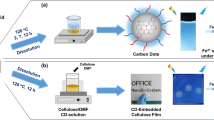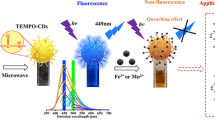Abstract
Cotton was chosen as the carrier for carbon quantum dots. The primary hydroxyl groups in the cotton cellulose were oxidized to carboxyl groups, and the nitrogen-containing carbon quantum dots were bonded to the oxidized cellulose through silane coupling agent KH-560. The obtained cellulose/carbon quantum dot composites (CKHCs) were characterized by FTIR, SED-EDS, XRD and XPS. The results indicated that carbon quantum dots were grafted on cellulose. CKHCs were used as the probes for a fluorescent Hg2+ detection, because Hg2+ could induce fluorescence quenching of carbon quantum dots. The sensing system exhibits excellent sensitivity and selectivity for Hg2+, with detection limits for mercury ions as low as 3 nM. The attachment of carbon quantum dots on cellulose makes the recycle of carbon quantum dots more convenient and improves the utilization of carbon quantum dots. The fit equations of the fluorescence intensity and Hg2+ concentrations for CKHC can test the unknown Hg2+ concentrations in the fluorescence quenching method, in which CKHC can be recycled to test the fluorescence quenching due to Hg2+ introduction.














Similar content being viewed by others
References
Abdelmouleh M, Boufi S, Belgacem M, Duarte A, Salah AB, Gandini A (2004) Modification of cellulosic fibres with functionalised silanes: development of surface properties. Int J Adhes 24(1):43–54
Ahmed A, Adnot A, Grandmaison J, Kaliaguine S, Doucet J (1987) ESCA analysis of cellulosic materials. Cellul Chem Technol 21(5):483–492
Åkerholm M, Hinterstoisser B, Salmén L (2004) Characterization of the crystalline structure of cellulose using static and dynamic FT-IR spectroscopy. Carbohydr Res 339(3):569–578
Barazzouk S, Daneault C (2012) Tryptophan-based peptides grafted onto oxidized nanocellulose. Cellulose 19(2):481–493
Brown RM (1996) The biosynthesis of cellulose. J Macromol Sci A 33(10):1345–1373
Chang PS, Robyt JF (1996) Oxidation of primary alcohol groups of naturally occurring polysaccharides with 2, 2, 6, 6-tetramethyl-1-piperidine oxoammonium ion. J Carbohydr Chem 15(7):819–830
Dai F, Wen M, Wang J, Jiang W, Tian X, Dong Y, Zhao Y, Chen L (2018) Preparation and properties of CA/ATP-g-CDs gel fibers for simultaneous detection and adsorption of methylene blue. RSC Adv 8(40):22577–22582
De Nooy A, Besemer A, Van Bekkum H (1994) Highly selective tempo mediated oxidation of primary alcohol groups in polysaccharides. Recl Trav Chim Pays-Bas 113(3):165–166
Duchemin B, Staiger MP (2009) Treatment of harakeke fiber for biocomposites. J Appl Polym Sci 112(5):2710–2715
Fathi B, Harirforoush M, Foruzanmehr M, Elkoun S, Robert M (2017) Effect of tempo oxidation of flax fibers on the grafting efficiency of silane coupling agents. J Mater Sci 52(17):10624–10636
Foruzanmehr M, Vuillaume PY, Elkoun S, Robert M (2016) Physical and mechanical properties of pla composites reinforced by TIO2 grafted flax fibers. Mater Des 106:295–304
French AD (2014) Idealized powder diffraction patterns for cellulose polymorphs. Cellulose 21:885–896
Guo TZ, Baasner J, Gradl M, Kistner A (1996) Determination of mercury in saliva with a flow-injection system. Anal Chim Acta 320(2–3):171–176
Han J, (2013) Preparation and characterization of cellulose nanoparticles and their application in biopolymeric nanocomposites
Huang M, Chen F, Jiang Z, Li Y (2013) Preparation of tempo-oxidized cellulose/amino acid/nanosilver biocomposite film and its antibacterial activity. Int J Biol Macromol 62:608–613
Johansson LS, Campbell JM (2004) Reproducible XPS on biopolymers: cellulose studies. Surf Interface Anal 36(8):1018–1022
Kamdem P, Zhang J, Adnot A (2001) Identification of cupric and cuprous copper in copper naphthenate-treated wood by X-ray photoelectron spectroscopy. Holzforschung 55(1):16–20
Klemm D, Heublein B, Fink HP, Bohn A (2005) Cellulose: fascinating biopolymer and sustainable raw material. Angew Chem Int Ed 44(22):3358–3393
Kumari S, Ram B, Kumar D, Ranote S, Chauhan GS (2018) Nanoparticles of oxidized-cellulose synthesized by green method. Mater Sci Energy Technol 1(1):22–28
Li H, Zhai J, Tian J, Luo Y, Sun X (2011) Carbon nanoparticle for highly sensitive and selective fluorescent detection of mercury (II) ion in aqueous solution. Biosens Bioelectron 26(12):4656–4660
Ling Z, Wang T, Makarem M et al (2019) Effects of ball milling on the structure of cotton cellulose. Cellulose 26(1):305–328
Llobet J, Falco G, Casas C, Teixido A, Domingo JL (2003) Concentrations of arsenic, cadmium, mercury, and lead in common foods and estimated daily intake by children, adolescents, adults, and seniors of Catalonia. Spain. J Agric Food Chem 51(3):838–842
Long Y, Jiang D, Zhu X, Wang J, Zhou F (2009) Trace Hg2+ analysis via quenching of the fluorescence of a CdS-encapsulated DNA nanocomposite. Anal Chem 81(7):2652–2657
Park S, Baker JO, Himmel ME, Parilla PA, Johnson DK (2010) Cellulose crystallinity index: measurement techniques and their impact on interpreting cellulase performance. Biotechnol Biofuel 3(1):10
Qian S, Sheng K (2017) PLA toughened by bamboo cellulose nanowhiskers: role of silane compatibilization on the pla bionanocomposite properties. Compos Sci Technol 148:59–69
Qian S, Sheng K, Yu K, Xu L, Lopez CA (2018) Improved properties of PLA biocomposites toughened with bamboo cellulose nanowhiskers through silane modification. J Mater Sci 53(15):10920–10932
Rao L, Tang Y, Lu H, Yu S, Ding X, Xu K, Li Z, Zhang J (2018) Highly photoluminescent and stable n-doped carbon dots as nanoprobes for Hg2+ detection. Nanomaterials 8(11):900
Renzoni A, Zino F, Franchi E (1998) Mercury levels along the food chain and risk for exposed populations. Environ Res 77(2):68–72
Rutter T, Hutton-Prager B (2018) Investigation of hydrophobic coatings on cellulose-fiber substrates with in-situ polymerization of silane/siloxane mixtures. Int J Adhes Adhes 86:13–21
Saito T, Isogai A (2004) Tempo-mediated oxidation of native cellulose: The effect of oxidation conditions on chemical and crystal structures of the water-insoluble fractions. Biomacromol 5(5):1983–1989
Saito T, Shibata I, Isogai A, Suguri N, Sumikawa N (2005) Distribution of carboxylate groups introduced into cotton linters by the tempo-mediated oxidation. Carbohydr Polym 61(4):414–419
Salon MCB, Gerbaud G, Abdelmouleh M, Bruzzese C, Boufi S, Belgacem MN (2007) Studies of interactions between silane coupling agents and cellulose fibers with liquid and solid-state NMR. Magn Reson Chem 45(6):473–483
Stern AH (2005) A review of the studies of the cardiovascular health effects of methylmercury with consideration of their suitability for risk assessment. Environ Res 98(1):133–142
Thakur MK, Gupta RK, Thakur VK (2014) Surface modification of cellulose using silane coupling agent. Carbohydr Polym 111:849–855
Wang H-T, Kang B, Chancellor T Jr, Lele T, Tseng Y, Ren F (2007) Fast electrical detection of Hg(II) ions with Al Ga N / Ga N high electron mobility transistors. Appl Phys Lett 91(4):042114
Wang LL, Graham DD, Robertson IM, Johnson D (2009) On the reversibility of hydrogen-storage reactions in Ca(BH4)2: characterization via experiment and theory. J Phys Chem C 113(46):20088–20096
Wang X, Yang X, Wang N, Lv J, Wang H, Choi MM, Bian W (2018) Graphitic carbon nitride quantum dots as an “off-on” fluorescent switch for determination of mercury (II) and sulfide. Microchim Acta 185(10):471
Wen T, Yang B, Guo Y, Sun J, Zhao C, Zhang S, Zhang M, Wang Y (2014) Organosilane-functionalized graphene quantum dots and their encapsulation into bi-layer hollow silica spheres for bioimaging applications. Phys Chem Chem Phys 16(42):23188–23195
Wirth S, Ulrich A (2002) Cellulose-degrading potentials and phylogenetic classification of carboxymethyl-cellulose decomposing bacteria isolated from soil. Syst Appl Microbiol 25(4):584–591
Xia Y-S, Zhu CQ (2008) Use of surface-modified cdte quantum dots as fluorescent probes in sensing mercury (II). Talanta 75(1):215–221
Xu X, Ray R, Gu Y, Ploehn HJ, Gearheart L, Raker K, Scrivens WA (2004) Electrophoretic analysis and purification of fluorescent single-walled carbon nanotube fragments. J Am Chem Soc 126(40):12736–12737
Xu Q, Zhang M, Liu Y, Cai W, Yang W, He Z, Sun X, Luo Y, Liu F (2018) Synthesis of multi-functional green fluorescence carbon dots and their applications as a fluorescent probe for Hg2+ detection and zebrafish imaging. New J Chem 42(12):10400–10405
Yan F, Kong D, Fu Y, Ye Q, Wang Y, Chen L (2016) Construction of carbon nanodots/tungsten trioxide and their visible-light sensitive photocatalytic activity. J Colloid Interface Sci 466:268–274
Yin Y, Ma J, Tian X, Jiang X, Wang H, Gao W (2018) Cellulose nanocrystals functionalized with amino-silane and epoxy-poly (ethylene glycol) for reinforcement and flexibilization of poly (lactic acid): material preparation and compatibility mechanism. Cellulose 25(11):6447–6463
Zahir F, Rizwi SJ, Haq SK, Khan RH (2005) Low dose mercury toxicity and human health. Environ Toxicol Pharmacol 20(2):351–360
Zheng W, Aschner M, Ghersi-Egea JF (2003) Brain barrier systems: a new frontier in metal neurotoxicological research. Toxicol Appl Pharmacol 192(1):1–11
Zhou L, Lin Y, Huang Z, Ren J, Qu X (2012) Carbon nanodots as fluorescence probes for rapid, sensitive, and label-free detection of Hg2+ and biothiols in complex matrices. Chem Commun 48(8):1147–1149
Acknowledgments
This research was supported by the National Nature Science Foundation of China (51462009, 51662011 and 21575100).
Author information
Authors and Affiliations
Corresponding authors
Additional information
Publisher's Note
Springer Nature remains neutral with regard to jurisdictional claims in published maps and institutional affiliations.
Rights and permissions
About this article
Cite this article
Zou, W., Ma, X. & Zheng, P. Preparation and functional study of cellulose/carbon quantum dot composites. Cellulose 27, 2099–2113 (2020). https://doi.org/10.1007/s10570-019-02926-8
Received:
Accepted:
Published:
Issue Date:
DOI: https://doi.org/10.1007/s10570-019-02926-8




